|
|
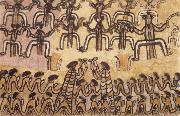 |
William Barak
|
|
Australian Aboriginal, ca.1824-1903
was the last traditional ngurungaeta (elder) of the Wurundjeri-willam clan, based around the area of present-day Melbourne, Australia. He became an influential spokesman for Aboriginal social justice and an important informant on Wurundjeri cultural lore. Barak was born in the early 1820s at Brushy Creek near present-day Croydon, in the country of the Wurundjeri people. His mother, Tooterrie, came from the Nourailum bulluk at Murchison, Victoria. His father, Bebejern, was an important member of the Wurundjeri clan. Beruk was said to have been present when John Batman met with the tribal elders to 'purchase' the Melbourne area in 1835. Before he died he described witnessing the signing of the treaty in a ceremony he called a tanderem. Ninggalobin, Poleorong and Billibellary were the leading song makers and principal Wurundjeri leaders in the Melbourne region. European colonisation had caused disruptions to initiation ceremonies. In response these three men gathered at South Yarra in the late 1830s and inducted the young William Barak into Aboriginal lore. This entailed formally presenting Barak with the symbols of manhood: strips of possumskin tied around his biceps; the gombert around his neck; given his ilbi-jerri, a sharp and narrow bone or nose-peg; and his branjep, the apron worn by men to cover their genitals. At the end of the ceremony Barack presented his uncle, Billibellary, a possumskin cloak. Beruk attended the government's Yarra Mission School from 1837 to 1839. When he joined the Native Mounted Police in 1844, he was given the name of William Barak. He was Police Trooper No.19. In early 1863, Barak moved to Coranderrk Station, near Healesville, Victoria with about thirty others. Upon the death of Simon Wonga in 1875, Barak became the Ngurungaeta of the clan. He worked tirelessly for his people and was a successful negotiator on their behalf. He was a highly respected man and leader, with standing amongst the Indigenous people and the European settlers. Figures in possum-skin cloaks, 1898 by William Barak.Barak is now best remembered for his artworks, which show both traditional Indigenous life and encounters with Europeans. Most of Barak's drawings were completed at Coranderrk during the 1880s and 1890s. They are now highly prized and exhibited in leading public galleries in Australia. His work is on permanent display in the National Gallery of Victoria Ian Potter Centre at Federation Square, Melbourne. Ceremony (1895) is housed at the Ballarat Fine Art Gallery. Barak died at Coranderrk in 1903 and is buried at the Coranderrk cemetery. |
|
|
|
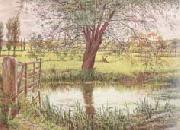 |
William Bell Scott
|
|
1811-1890
Brother of David Scott. He trained at the Trustees' Academy in Edinburgh and was taught engraving by his father. He saw the family print workshop as 'the lineal descendant of Albert Derer's factory in Nernberg'; he was later to own a fine collection of D?rer's prints and write a book about him (1870). In 1837 he went to London, where he was impressed by 'a new and interesting school of historical and loosely speaking, inventive and illustrative painters'. This encouraged him to leave landscape painting for the time being and become a history painter. Like his brother, he entered a cartoon for the Westminster Hall competition in 1842: the Free North Britons Surprising the Roman Wall between the Tyne and Solway; this too was unsuccessful. In 1843, discouraged by lack of patronage in London, he accepted the Mastership of the Government School of Design at Newcastle upon Tyne, where he stayed for 20 years, visiting London each summer. |
|
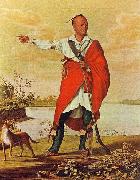 |
William Berczy
|
|
(December 10, 1744, Wallerstein near Noerdlingen, Germany - February 5, 1813, New York City, USA) was a German pioneer and painter.
Born in Swabia, Germany as a son of the Wirklicher Hofrat Albrecht Theodor Moll and Johanna Josepha Walpurga Moll nee Hefele, he was originally named Johann Albrecht Ulrich Moll, but later changed his name. He studied at the Akademie der bildenden Kenste in Vienna and at the University of Jena in Saxony. His early career was spent in several European countries, including Italy (meeting with Johann Wolfgang von Goethe in Florence) and England, where he exhibited at the Royal Academy. In 1792 he sailed for the Americas, setting up a business in York (now - since 1834 - Toronto) a couple of years later. He also worked in Quebec. Although best known for his portraits, he also carried out religious paintings and architectural work, including plans for Christ Church Cathedral in Montreal in 1803, and was a surveyor.
|
|
|
|
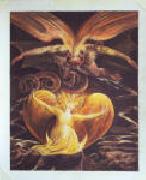 |
William Blake
|
|
1757-1827
British
William Blake Galleries
William Blake started writing poems as a boy, many of them inspired by religious visions. Apprenticed to an engraver as a young man, Blake learned skills that allowed him to put his poems and drawings together on etchings, and he began to publish his own work. Throughout his life he survived on small commissions, never gaining much attention from the London art world. His paintings were rejected by the public (he was called a lunatic for his imaginative work), but he had a profound influence on Romanticism as a literary movement.
|
|
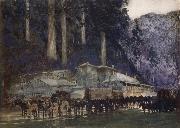 |
William Blamire Young
|
|
English Australian artist .
1862-1935
known as Blamire Young, was an English Australian artist. Young was born at Londesborough, Yorkshire, the second son of a family of 12. His father, Colonel Young, came of prosperous yeoman stock. Blamire Young was educated at the Forest School, Walthamstow, where he received a classical training, and going on to Cambridge University specialized in mathematics. That he completed his course with no better than third-class honours was no doubt partly caused by his discovery of the print collection in the Fitzwilliam Museum, and his association with the Cambridge Fine Art Society. It had been intended that he should become a clergyman, but Young felt that he had no vocation for that work and obtained the position of mathematical master at Katoomba College, Katoomba, New South Wales, which had been founded by John Walter Fletcher in 1884. Young remained at the school for eight years. In his spare time he practised painting, and meeting Phil May received some instruction from him in painting in oil. In 1893, he returned to England and after working for a few months under Hubert von Herkomer, became associated with James Pryde and William Nicholson in poster work. In 1895 Young returned to Australia and with the Lindsay brothers and Harry Weston did some excellent posters. But the field was limited and many years of poverty followed, during which a certain amount of writing was done for the press. He began exhibiting at the Victorian Artists' Society, but sales were few and the one-man show was then unknown. During his visit to England he had married Mabel Sawyer, an expert wood-carver, and while the lean period lasted Mrs Young helped to keep the house going by executing commissions for Melbourne architects. It was not until 1911 that the appreciation of Young's art really began to be shown. In that year he held an exhibition at Melbourne of small pictures, some of which had similar qualities to the Japanese coloured wood-cuts of the eighteenth century. Sales were good, partly because the prices were low, and the artist was sufficiently encouraged to hold an exhibition at Adelaide. This was both an artistic and a financial success, other shows followed in Melbourne and Sydney, and at last, in his fiftieth year, Young's reputation as an artist was established. In 1912 he sailed for Europe and after a stay in Spain settled in England. Eighteen months later in August 1914 his first show, opened at the Bailey Galleries. All the arrangements had been made and the pictures hung when war broke out. Young had been a good marksman in his youth, and for three years worked as an instructor in musketry and machine-gunnery. Immediately after the war he took up his painting again and exhibited at the Academy and the Royal Society of British Artists. Back in Australia in 1923 Young established himself at Montrose in the hills about 20 miles east of Melbourne. He acted as art critic for the The Herald and held occasional one-man shows. |
|
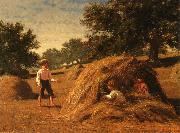 |
William Bliss Baker
|
|
(1859 - 1886-11-20) was an American artist born in New York City who was just beginning to hit his stride as a landscape painter in the Realism movement when he died at his father's house at Hoosick Falls, New York at the age of 27 due to a back injury received while ice skating several months earlier
Baker studied at the National Academy of Design for four years beginning in 1876,where he won first prize during his first exhibit in 1879. By 1881, Baker had set up a studio north of Albany, New York. |
|
|
|
|
|
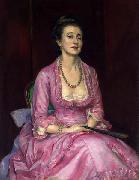 |
William Bruce Ellis Ranken
|
|
United Kingdom (1881- 1941 ) - Watercolours
painted Souvenir of the seventies. Signed with monogram and dated 1923 |
|
|
|
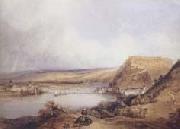 |
William Callow
|
|
British Painter, 1812-1908
1812-1908.English painter and engraver. The son of a carpenter and builder, Callow was apprenticed at the age of 11 to Theodore Fielding, with whom he remained for two years. Copley Fielding also took an interest in his progress. In 1825 Callow was articled to Theodore Fielding for eight years' instruction in watercolour drawing and aquatint engraving. However, in 1829 he left for Paris, at the invitation of Thales Fielding, to work for the publisher J. F. d'Ostervald. He lived and worked with Newton Fielding until 1830, when the events of the July Revolution forced them back to Britain. Callow was again in Paris by February 1831 and returned to London only in 1841. |
|
|
|
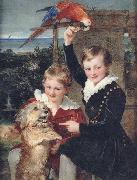 |
William Charles Ross
|
|
English Miniature Painter, 1794-1860
was a British painter. Early in his career, he was known for historical paintings, but he later gained fame for his miniatures and portraits. He was made a member of the Royal Academy in 1842. |
|
|
|
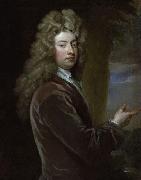 |
William Congreve
|
|
(24 January 1670 - 19 January 1729) was an English playwright and poet.
Congreve was born in Bardsey, West Yorkshire, England (near Leeds). His parents were William Congreve (1637-1708) and his wife, Mary; a sister was buried in London in 1672. He spent his childhood in Ireland, where his father, a Cavalier, had settled during the reign of Charles II. Congreve was educated at Trinity College in Dublin; there he met Jonathan Swift, who would be his friend for the remainder of his life. Upon graduation, he matriculated in the Middle Temple in London to study law, but felt himself pulled toward literature, drama, and the fashionable life. |
|
 |
William Cruikshank
|
|
William Cruikshank (December 25, 1848, Broughty Ferry, Scotland e May 19, 1922, Kansas City, Missouri) was a British painter and the grand-nephew of George Cruikshank. He studied art at the Royal Scottish Academy in Edinburgh, at the Royal Academy in London, and in Paris. His last studies were interrupted by the Franco-Prussian War. In 1871 he settled in Canada, opened a studio in Toronto and for twenty-five years was an instructor in the Central Ontario School of Art, later the Ontario College of Art. In 1894 he was elected a member of the Royal Canadian Academy of Arts and acquired a considerable reputation as a portrait and figure painter, and as a painter of Canadian scenes. Some of his paintings are in the National Gallery of Canada |
|
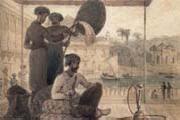 |
William Daniell
|
|
English, 1769-1837, was a British draughtsman. Castle Broichin on the Isle of Raasay. 1819 aquatint by William DaniellDaniell was fourteen when he accompanied his uncle Thomas Daniell to India |
|
|
|
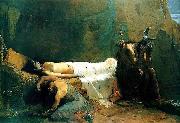 |
William de Leftwich Dodge
|
|
(1867-1935) was an American artist best known for his murals, which were commissioned for both public and private buildings.
Dodge was born at Liberty, Virginia in the Piedmont near Lynchburg. In 1879, his mother, Mary de Leftwich Dodge, an aspiring artist, moved her family to Europe. After living initially in Munich they moved to Paris, where she worked on art. Dodge later followed her example and became an artist. He spent most of his childhood years in France, where his mother was working on art. He studied at the École des Beaux Arts and took first place in the examinations in 1881. He also studied under Jean-Leon Gerôme and with Raphaël Collin at the Academie Colarossi,[1] and traveled to Munich for studies there.
|
|
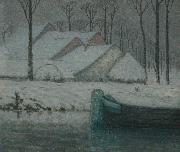 |
William Degouwe de Nuncques
|
|
(28 February 1867 - 1 March 1935) was a Belgian painter.
He was born at Montherme, the Ardennes, France, of an old aristocratic family, After the Franco-Prussian war (1870-71), his parents settled in Belgium, and he taught himself to paint. In 1894 he married fellow artist Juliette Massin, who introduced him to the circle of Symbolist poets, who had a considerable influence on his style. He belonged to the avant-garde group Les XX and later exhibited at La Libre Esthetique. He travelled widely and painted views of Italy, Austria and France, often of parks at night. His best-known pictures, Pink House (1892), The Angels (1894), and Peacocks (1896), demonstrate the magical quality of his work. Pink House is thought to have been a major influence on Surrealism, especially the paintings of Rene Magritte.
He is supposed to have said "To make a painting, all you need to do is to take some paints, draw some lines, and fill the rest up with feelings." A regular exhibitor in Paris, he was championed by Puvis de Chavannes and Maurice Denis.
From 1900 to 1902 he and his wife lived in the Balearic Islands, where he painted the rugged coastline and the orange groves. After suffering a religious crisis around 1910, he painted pictures that revealed his tormented state of mind, and during World War I, while a refugee in the Netherlands, he produced only minor works. In 1919 he was overwhelmed by the death of his wife and lost the use of one hand. In 1930 he married the woman who had helped him through the crisis. They settled in Stavelot, where he spent his last few years painting snow-covered landscapes.
The best collection of his paintings is in the Kröller-Meller Museum, Otterlo.
|
|
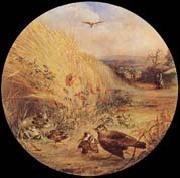 |
William Dexter
|
|
Australian, 1818-1860,was an English-Australian painter. Dexter was born at Melbourne, Derbyshire, England, and became an apprentice at the Derby China factory painting flowers and birds in the Chinese and Japanese styles. Dexter then studied at Paris, and returning to England, married Caroline nee Harper at Nottingham in 1843. Dexter had a picture in the Royal Academy exhibition in 1851 and another in 1852. Dexter then sailed to Australia and arrived at Sydney on 8 October 1852. Dexter was at Bendigo in August 1853, where William Howitt heard him advocating republican doctrines at a meeting of diggers. His wife came out from England at the end of 1854, and in March 1855 they together opened a gallery of arts and school of design in Bathurst Street, Sydney. This apparently was not a success for they went to live at Stratford, Victoria, in 1856, and there made the acquaintance of Angus McMillan. In 1857 Dexter exhibited six oils and three watercolours at the first Victorian Society of Fine Arts exhibition, held in Melbourne. Soon afterwards he returned to Sydney as the Dexters had separated. He became a partner in a sign-writing business, dying there in 1860. |
|
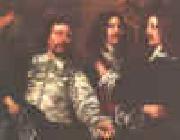 |
William Dobson
|
|
1610-1646
English
William Dobson Locations
William Dobson (March 4, 1610 ?C October 28, 1646) was a portraitist and one of the first notable English painters, praised by his contemporary John Aubrey as the most excellent painter that England has yet bred.
Dobson was born in London the son of a decorative artist, and was apprenticed to William Peake and probably later joined the studio of Francis Cleyn. He is believed to have had access to the Royal Collection and to have copied works by Titian and Anthony Van Dyck, King Charles I chief painter. The colour and texture of Dobson work was influenced by Venetian art, but Van Dyck style has little apparent influence on Dobson. Van Dyck himself discovered Dobson when he noticed one of the young artists pictures in a London shop window. He introduced Dobson to the King, who had Dobson paint himself, his sons and members of the court.
When Van Dyck died in 1641, Dobson probably succeeded him as sergeant-painter to the King, though proof is lacking. During the English Civil War Dobson was based at the Royalist centre of Oxford and painted many leading Cavaliers. His portrait of the future Charles II as Prince of Wales at the age of around twelve is a notable baroque composition, and perhaps his finest work. He also painted the Duke of York, Prince Rupert of the Rhine and Prince Maurice.
Charles II when Prince of Wales, circa 1642 or 1643.Around sixty of Dobson works survive, mostly half-length portraits most of them dated from 1642 or later. The thick impasto of his early work gave way to a mere skim of paint, perhaps reflecting a wartime scarcity of materials. After Oxford fell to the Parliamentarians, in June 1646, Dobson returned to London. Now without patronage, he was briefly imprisoned for debt and died in poverty at the age of thirty-six.
Dobson is regarded as a talented painter with a fine sense for colour and good powers of observation. However, an entirely English training such as Dobson could not be first rate in the early 17th century and he had technical weaknesses[citation needed]. There are examples of Dobson work at Tate Britain and the National Portrait Gallery in London and at several English country houses. The most comprehensive study of Dobson and his work is William Dobson, 1611?C1646 an exhibition catalogue written by M. Rogers for a 1983 exhibition at the National Portrait Gallery. |
|
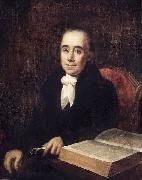 |
William Dunlap
|
|
(1 February 1766 - 28 September 1839) was a pioneer of the American theater. He was a producer, playwright, and actor, as well as a historian. He managed two of New York's earliest and most prominent theaters, the John Street Theatre (from 1796?C98) and the Park Theatre (from 1798?C1805). He was also an artist, despite losing an eye in childhood.
He was born in Perth Amboy New Jersey, the son of an army officer wounded at the Battle of Quebec in 1759. In 1783, he produced a portrait of George Washington, now owned by the United States Senate, and later studied art under Benjamin West in London. After returning to America in 1787, he worked exclusively in the theater for 18 years, resuming painting out of economic necessity in 1805. By 1817, he was a full-time painter.
In his lifetime he produced more than sixty plays, most of which were adaptations or translations from French or German works. A few were original: these were based on American themes and had American characters. However, he is best known for his encyclopedic three-volume History of the Rise and Progress of the Arts of Design in the United States, which was published in 1834, and which is now an invaluable source of information about artists, collecting, and artistic life generally in the colonial and federal periods.
|
|
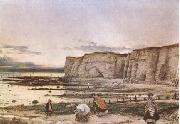 |
William Dyce
|
|
1806-1864
Scottish painter, educationalist, theorist and designer. The son of a lecturer in medicine at Marischal College, Aberdeen, he studied medicine and theology, obtaining his Master's degree in 1823. Episcopalian by upbringing, Dyce was expected, like his cousin, the scholar and bibliophile Alexander Dyce (1798-1869), to proceed to Oxford to take orders. His early interest in art found an outlet in portraiture, his first commission being Sir James M. D. M'Grigor (1823; U. Aberdeen). His first attempt at history painting, The Infant Hercules Strangling the Serpents sent by Juno to Destroy Him (1824; Edinburgh, N.G.), much influenced by Reynolds, was shown to Sir Thomas Lawrence, who is said to have encouraged Dyce to enter the Royal Academy Schools in 1825. After a few months he set off for Rome in the company of Alexander Day; |
|
|
|
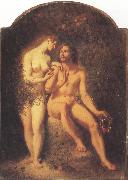 |
William Edward frost R.A.
|
|
1810-1877
was an English painter of the Victorian era. Virtually alone among English artists in the middle Victorian period, he devoted his practice to the portrayal of the female nude. Frost was educated in the schools of the Royal Academy, beginning in 1829; he established a reputation as a portrait painter before branching into historical and mythological subjects, including the sub-genre of fairy painting that was characteristic of Victorian art. In 1839 he won the Royal Academy's gold medal for his "Prometheus Bound," and in 1843 he won a prize in the Westminster Hall competition for his "Una Alarmed by Fauns" (a subject from Spenser's The Faerie Queen). He was elected an associate member of the Royal Academy in 1846, and a full member in 1870. Frost is widely recognized as a follower of William Etty, who preceded him as the primary British painter of nudes in the second quarter of the nineteenth century. |
|
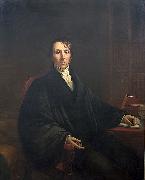 |
William Ellery Channing
|
|
(April 7, 1780 - October 2, 1842) was the foremost Unitarian preacher in the United States in the early nineteenth century and, along with Andrews Norton, one of Unitarianism's leading theologians. He was known for his articulate and impassioned sermons and public speeches, and as a prominent thinker in the liberal theology of the day. |
|
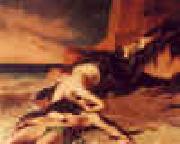 |
William Etty
|
|
1787-1849
English
William Etty Location
English painter. Born into a Methodist family, he was the seventh child of a miller and baker in Feasegate, York, and in 1798 he was apprenticed as a printer to Robert Peck, publisher of the Hull Packet. Financial support from his uncle, a banker, allowed him to go to London in 1805, where he entered the Royal Academy Schools in 1806. For a year, in 1807-8, he was a pupil of Thomas Lawrence, who greatly influenced him. Following the death of his uncle in 1809 he became financially secure. From 1811 he exhibited regularly at the Royal Academy and the British Institution and in 1816 worked in the studio of Jean-Baptiste Regnault in Paris. |
|
|
|
|
|
|
|
|
|
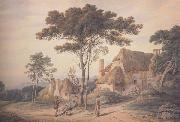 |
William Frederick Wells
|
|
A landscape painter in watercolor, Wells was the true founder of the Society of Painters in Watercolors in 1804 and its president in 1806-07. He studied under J. J. Barralet and exhibited at the Royal Academy from 1795 to 1804 and at the Watercolor Society to 1813, when he resigned.
|
|
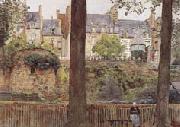 |
William Frederick Yeames,RA
|
|
1835-1918
English painter. The son of a British consul in Russia, Yeames was sent to school in Dresden after the death of his father in 1842. He also studied painting there. The collapse of the Yeames family fortune resulted in a move to London in 1848, where Yeames learnt anatomy and composition from George Scharf (1788-1860). He later took lessons from F. A. Westmacott. In 1852 he continued his artistic education in Florence under Enrico Pollastrini and Raphael Buonajuto, from whom he learnt the methods of the Old Masters. He drew from frescoes by Ghirlandaio, Gozzoli and Andrea del Sarto and painted in the Life School at the Grand Ducal Academy. He then went to Rome and made landscape studies and copied Old Masters, including Raphael's frescoes in the Vatican. His extensive study of Italian art gave him a precision and facility that assisted his artistic success upon his return to London in 1859. There he set up a studio in Park Place and became involved with the ST JOHN'S WOOD CLIQUE. He exhibited at the Royal Academy and the British Institution from 1859 and became an ARA in 1866. |
|
|
|
|
|
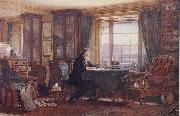 |
William Gershom Collingwood
|
|
artist and historian, (1854-1932)
was an author, artist, antiquary and was also Professor of Fine Arts at the Reading University. He was born in Liverpool. In 1872, he went to University College, Oxford, where he met John Ruskin. During the summer of 1873 Collingwood visited Ruskin at Brantwood, Coniston. Two years later Collingwood was working at Brantwood with Ruskin and his associates. Ruskin admired his draughtsmanship, and so Collingwood studied at the Slade School of Art between 1876 and 1878. He exhibited at the Royal Academy in 1880. For many years Collingwood dedicated himself to helping Ruskin, staying at Brantwood as Ruskin's assistant and travelling with him to Switzerland. In 1883 he married Edith Mary Isaac (1857C1928) and settled near to Ruskin in the Lake District. Collingwood edited a number of Ruskin's texts and published a biography of Ruskin in 1893. In 1896, Arthur Ransome met the Collingwoods and their children, Dora (later Mrs Ernest Altounyan), Barbara (later Mrs Oscar Gnosspelius), Ursula, and Robin (the later historian and philosopher). Ransome learned to sail in Collingwood's boat, Swallow, and became a firm friend of the family, even proposing marriage to both Dora and Barbara (on separate occasions). After a summer of teaching Collingwood's grandchildren to sail in Swallow II in 1928, Ransome wrote the first book in his Swallows and Amazons series. He used the names of some of Collingwood's grandchildren for his characters, the Swallows. By the 1890s Collingwood had become a skilled painter and also joined the Cumberland and Westmorland Antiquarian and Archaeological Society. He wrote a large number of papers for its Transactions; becoming editor in 1900. Collingwood was particularly interested in Norse lore and the Norsemen, and he wrote a novel, Thorstein of the Mere which was a major influence on Arthur Ransome. Collingwood was a member of the Viking Club and served as its president. His study of Norse and Anglican archaeology made him widely recognized as a leading authority. Following Ruskin's death Collingwood continued to help for a while with secretarial work at Brantwood, but in 1905 went to University College, Reading and served as professor of fine art from 1907 until 1911. |
|
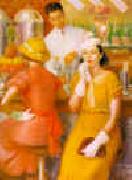 |
William Glackens
|
|
1870-1938
William Glackens Galleries
William James Glackens (March 13, 1870?CMay 22, 1938) was a U.S. realist painter.
Glackens studied at the Pennsylvania Academy of the Fine Arts and later moved to New York City, where he co-founded what came to be called the Ashcan School art movement. This group of artists, dubbed by the press "the Eight Independent Painters" or The Eight, chose to exhibit their works without pre-approval by the juries of the existing art establishment. He became known for his dark-hued paintings of street scenes and daily life in the city's neighborhoods. His later work was brighter in tone, and showed the influence of Renoir. During much of his career as a painter, Glackens also worked as an illustrator for newspapers and magazines in Philadelphia and New York City. |
|
|
|
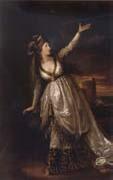 |
William Hamilton
|
|
English Painter, 1751-1801, was an English painter and illustrator. Hamiliton was born in Chelsea, London, but travelled and worked in Italy with Antonio Zucchi for several years. He trained first as an architectural draftsman, but soon moved to theatrical portraits and scenes from plays. Hamilton became very well known for his paintings depicting episodes from the plays of Shakespeare and for his illustrations of poems. He was commissioned to create works for John Boydell's Shakespeare Gallery, Macklin's Bible and Bowyer's English History. These were widely reproduced in popular prints. Francesco Bartolozzi engraved a number of Hamilton??s best known works. He also painted modern events, such as the execution of Marie Antoinette, in the manner of epic historical drama. Hamilton's style shows the influence of the cult of sentiment typical of the period, resembling the work of Angelica Kauffmann. He also sometimes adopts aspects of Fuseli's dramatic distortions in composition and figure drawing. He became an associate member of the Royal Academy from 1784, and was made a full member in 1789. |
|
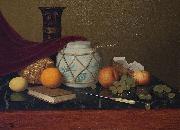 |
William Harnett
|
|
(August 10, 1848 - October 29, 1892) was an Irish-American painter known for his trompe l'oeil still lifes of ordinary objects.
Harnett was born in Clonakilty, County Cork, Ireland during the time of the potato famine. Shortly after his birth his family emigrated to America, settling in Philadelphia. Becoming a United States citizen in 1868, he made a living as a young man by engraving designs on table silver, while also taking night classes at the Pennsylvania Academy of the Fine Arts and later, in New York, at Cooper Union and at the National Academy of Design. His first known oil painting, a still life, dates from 1874.
|
|
|
|
|
|
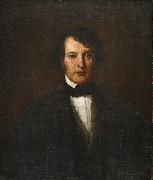 |
William Henry Furness
|
|
(1802-1896) was an American clergyman, theologian, reformer and abolitionist. Following the American Civil War, he raised funds for Black schools in the South, including Morehouse College.
A graduate of the Theological Department of Harvard University, Furness became the Minister of the First Unitarian Church of Philadelphia at the age of 22. A close friend of Ralph Waldo Emerson, Furness presided over a period marked by the growth and increasing prosperity for First Church. A fiery abolitionist, Furness was a supporter of the rights of all segments of society, including African-Americans and Jews. He also lived to see the construction of the current church building in 1885 in the role of Minister Emeritus.
Rev. Furness was the father of painter William Furness, Shakespearean scholar Horace Howard Furness, architect Frank Furness, and author and translator Annis Furness Lee.
|
|
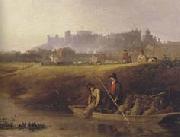 |
William henry hunt
|
|
English Painter, 1790-1864
was an English watercolour painter. He was born near Long Acre, London, and was apprenticed in about 1805 to John Varley, the landscape-painter, with whom he remained five or six years. He exhibited three oil pictures at the Royal Academy in 1807. He became connected with the Society of Painters in Water Colours at its beginning, and was elected an associate in 1824 and a full member in 1827. Until the year of his death, he was one of the most prolific contributors to the Society's exhibitions. Many years of Hunt's uneventful but industrious life were spent at Hastings. He died of apoplexy. Hunt was one of the creators of the English school of water-color painting. His subjects, especially those of his later life, are extremely simple; but, by the delicacy, humor and fine power of their treatment, they rank second to works of the highest art only. Considered technically, his works exhibit all the resources of the water-color painter's craft, from the purest transparent tinting to the boldest use of gouache, rough paper and scraping for texture. His sense of color is perhaps as true as that of any English artist. He was, says John Ruskin, all in all, the finest ever painter of still life. Several characteristic examples of Hunt's work, as the "Boy and Goat," "Brown Study and Plums," "Primroses and Birds' Nests" are in the Victoria and Albert Museum. |
|
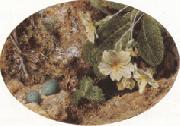 |
william henry hunt,o.w.s
|
|
1790-1864
was an English watercolour painter. He was born near Long Acre, London, and was apprenticed in about 1805 to John Varley, the landscape-painter, with whom he remained five or six years. He exhibited three oil pictures at the Royal Academy in 1807. He became connected with the Society of Painters in Water Colours at its beginning, and was elected an associate in 1824 and a full member in 1827. Until the year of his death, he was one of the most prolific contributors to the Society's exhibitions. Many years of Hunt's uneventful but industrious life were spent at Hastings. He died of apoplexy. Hunt was one of the creators of the English school of water-color painting. His subjects, especially those of his later life, are extremely simple; but, by the delicacy, humor and fine power of their treatment, they rank second to works of the highest art only. Considered technically, his works exhibit all the resources of the water-color painter's craft, from the purest transparent tinting to the boldest use of gouache, rough paper and scraping for texture. His sense of color is perhaps as true as that of any English artist. He was, says John Ruskin, all in all, the finest ever painter of still life. Several characteristic examples of Hunt's work, as the "Boy and Goat," "Brown Study and Plums," "Primroses and Birds' Nests" are in the Victoria and Albert Museum. |
|
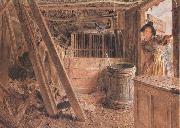 |
William Henry Hunt,OWS
|
|
1790-1864
was an English watercolour painter. He was born near Long Acre, London, and was apprenticed in about 1805 to John Varley, the landscape-painter, with whom he remained five or six years. He exhibited three oil pictures at the Royal Academy in 1807. He became connected with the Society of Painters in Water Colours at its beginning, and was elected an associate in 1824 and a full member in 1827. Until the year of his death, he was one of the most prolific contributors to the Society's exhibitions. Many years of Hunt's uneventful but industrious life were spent at Hastings. He died of apoplexy. Hunt was one of the creators of the English school of water-color painting. His subjects, especially those of his later life, are extremely simple; but, by the delicacy, humor and fine power of their treatment, they rank second to works of the highest art only. Considered technically, his works exhibit all the resources of the water-color painter's craft, from the purest transparent tinting to the boldest use of gouache, rough paper and scraping for texture. His sense of color is perhaps as true as that of any English artist. He was, says John Ruskin, all in all, the finest ever painter of still life. Several characteristic examples of Hunt's work, as the "Boy and Goat," "Brown Study and Plums," "Primroses and Birds' Nests" are in the Victoria and Albert Museum. |
|
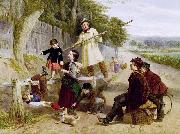 |
William Henry Knight
|
|
(26 September 1823 - 31 July 1863) was an English portrait and genre painter.
Knight was born in Newbury, Berkshire where his father, John Knight, was a schoolmaster. He was to become a solicitor, but gave up his law studies after two of his paintings were accepted by the annual exhibition of the Society of British Artists. He moved to London in 1855, taking lodgings in Kennington Road, Lambeth, and supporting himself by drawing crayon portraits while studying in the British Museum and in the schools of the Royal Academy.
|
|
|

